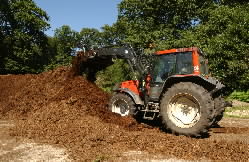 Recent legislation on diverting organic wastes from landfill means that composts created from waste organic materials are becoming more readily available. These composts have much to offer those involved in creating greenspace. Added to mineral soil-forming materials, they can:
Recent legislation on diverting organic wastes from landfill means that composts created from waste organic materials are becoming more readily available. These composts have much to offer those involved in creating greenspace. Added to mineral soil-forming materials, they can:
There are several types of compost on the market, depending on the type of source material. These include green waste compost, spent mushroom compost, composted municipal wastes and composted sewage sludge.
Composts are rarely free, so their use in greenspace projects must be planned carefully. For establishing trees, composts are probably needed only where soil materials lack organic matter, or where residual soil contamination is likely to impair tree performance. Different compost products may behave differently when incorporated in the soil, and may support some types of vegetation preferentially, so it is important to match products to plant and tree species. Other organic materials such as sewage sludges should also be considered, especially if they are lower in cost.
It is important to identify:
For sites where contamination is not an issue, compost should be considered as one type of organic amendment to mineral soil-forming materials.
The roots™ software gives good guidance on how to calculate appropriate amounts. If compost is considered for its potential ability to reduce the mobility of contaminants, current recommendations are to conduct bioassay tests to establish whether vegetation can be sustained on the constructed medium, and leachate tests to examine the risk of contaminant movement.
Composts used in land regeneration should comply with standards given in the British Standards Institution’s publicly available specification PAS 100, and analyses should be undertaken of samples from material potentially to be used on-site. It is vital that compost materials used are mature, and that fermentation processes have been completed.
Consideration should be given on whether to incorporate compost into soil or soil-forming materials in a separate operation before placing on-site, or to spread compost after soil placement and incorporate it into the soil by complete cultivation.
Forest Research was involved in two projects funded by EPSRC under the SUBR:IM (Sustainable Urban Brownfield Remediation: Integrated Management) Consortium.
The first, ‘Novel special-purpose composts for the sustainable remediation of brownfield sites’ developed a novel sustainable remediation technique that relies on the use of waste produced materials (composts) combined with naturally occurring minerals (clays, zeolites) in order to enhance the biodegradation and immobilisation capability of the compost. This was based on nursery trials to evaluate the effectiveness of the technology by monitoring the bio-availability of the contaminants of concerns to plants under specific experimental conditions.
The second, ‘Integrated urban remediation and greening’ aimed, amongst other objectives, to test the suitability of remediated soil materials for vegetation establishment.
A summary of the results from these two trials is available in a CL:AIRE SUBR:IM Bulletin ‘The use of compost in the regeneration of brownfield land’ (PDF-409K).
Forest Research has conducted innovative research to establish how compost materials can be used in brownfield remediation, and is well placed to test new or novel materials. Guidance on the use of composts can also be produced.
Forest Research can also offer a site-specific consultancy service for landowners, remediation engineers or compost producers interested in using compost for greenspace establishment.
Kilbride, C. (2006). Application of Sewage Sludges and Composts (PDF-317K). Best Practice Guidance for Land Regeneration, BPG Note 6. Forest Research, Farnham.
van Herwijnen, R., Sellers, G., Sinnett, D., Moffat, A.J., Hutchings, T.R., Al-Tabbaa, A. and Ouki, S. (2008). The Use of Compost in the Regeneration of Brownfield Land (PDF-409K). CL:AIRE SUBR:IM Bulletin 10 (Contaminated Land: Applications in Real Environments/Sustainable Urban Brownfield Regeneration: Integrated Management.)
Moffat, A. (2006). Use of Sewage Sludges and Composts in Forestry. Forestry Commission information Note 79. Forestry Commission, Edinburgh.
Muddy Boots et al. (2005). roots: The Definitive Software Tool for Land Reclamation. Muddy Boots Software Ltd/Progressive Restoration, Ross-on-Wye.
WRAP (2005). Introduction to PAS 100:2005. Summary of the BSI Specification for Composted Materials. Waste & Resources Action Programme, UK.
WRAP (2006). Restoring the Land with Compost. Waste & Resources Action Programme, UK.